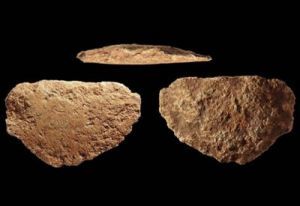
© Monash University/Bruno DavidThe pieces of ground-edge stone axe was found in west Arnhem Land.
A shard of stone estimated to be 35,500 years old is a fragment of what could be the world's oldest ax.
Aboriginal Jawoyn people from Arnhem Land could have been the first to grind axes to sharpen their edges.
Archaeologist previously believed that ground-edge axes first emerged in Europe 20,000-30,000 years ago.
Archaeologists revealed they have found a piece of a stone ax dated as 35,500 years old on sacred Aboriginal land in Australia, the oldest object of its type ever found.
The shard of stone, found in Australia's lush and remote far northern reaches in May, has marks that prove it comes from a ground-edge stone ax, Monash University's Bruno David said on Friday.
"We could see with the angled light that the rock itself has all these marks on it from people having rubbed it in order to create the ground-edge ax," he told the ABC.
"The person who was using the ax was grinding it against a sandstone surface in order to make it a smoother surface."
David said the previous oldest ground-edge axes were 20,000 to 30,000 years old, and the conventional belief was that the tool first emerged in Europe when populations grew and forests flourished at the end of the last Ice Age.
"What we've got in Australia, however, is evidence of ground-edge axes going back 35,000 years ago," he said.
"What this all means is that we know that the conventional story that comes from Europe does not explain the origin of axes globally. So we've got to think of it in a very different way."
David said the discovery is evidence that Aboriginal Jawoyn people from Arnhem Land could have been the first to grind axes to sharpen their edges.
"It means that you're creating a tool that is far more efficient than what you had before, and that you also have to create a tool not just through a simple series of actions of hitting against it," he said.
The piece of stone was found in a remote patch of the Northern Territory amid traditional Aboriginal rock art paintings believed to date back thousands of years.
"It's a very remote location, it's quite a spectacular site that is covered in rock art," David said, adding that the cave where the stone was found was well protected from the elements.
Jawoyn Aboriginal people, who had invited the archaeologists to their land to examine the site, said the find was a meaningful connection to their ancestors.
"They (the archaeologists) study about rocks and bone and everything and I wanted to know the truth," landowner Margaret Katherine told the ABC.
"Now that I know the truth I am very happy deep inside."
Arnhem Land, a 97,000 square kilometer (38,800 square mile) patch of forests, rivers and gorges east of the Northern Territory capital of Darwin, is sacred to Aboriginal people.

Reader Comments
to our Newsletter